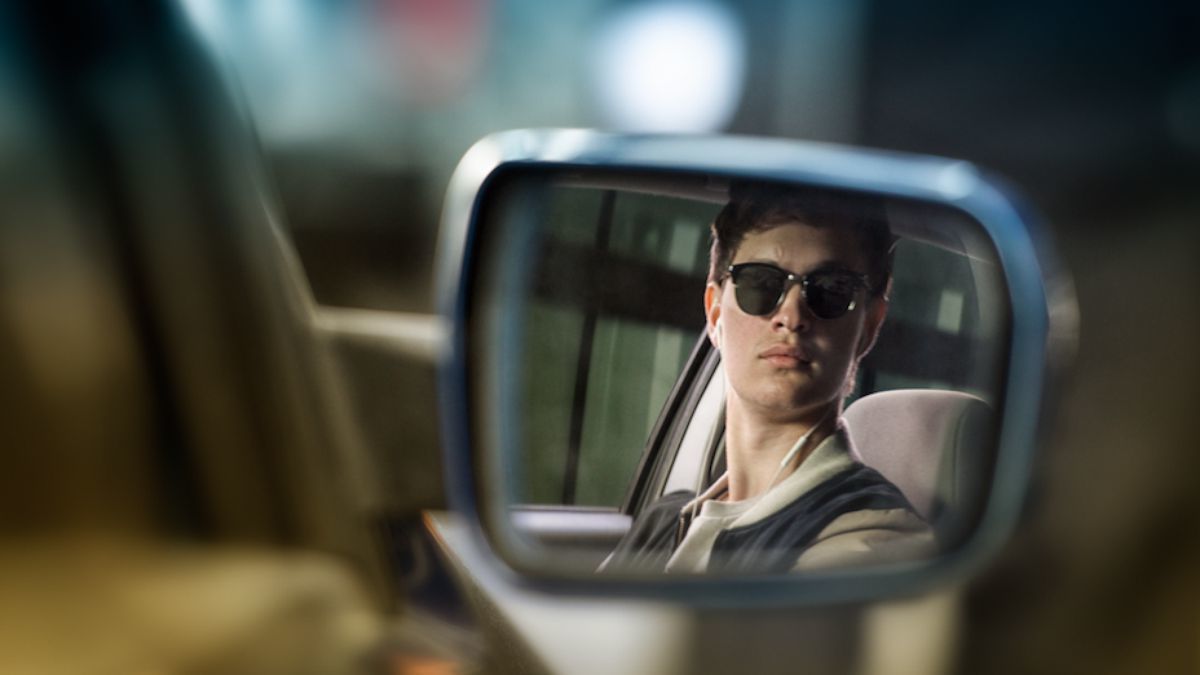
The first 30 minutes of Edgar Wright’s Baby Driver are near perfection. A handsome, baby-faced young man (Ansel Elgort), wearing what we’ll soon find to be his ever-present sunglasses and headphones, waits in the getaway car outside of a bank, listening to the opening strains of a Jon Spencer Blues Explosion song. As the somewhat dissolute trio of bank robbers rush into the car, the music gets louder and he peels out. He’s a virtuoso driver, making corkscrew turns and split-second changes of direction, all in time to the frenetic beat. Despite the dozens of cops on his tail, he makes it back to headquarters.
From there, he goes on a coffee run, gliding down the street, lip-syncing to the music in his headphones, interacting with passersby like he’s in his own private musical. He’s a hepcat, a 21st-century version of the kind of smooth, finger-snapping young men we used to see in Jean-Luc Godard films. He brings the coffee back to headquarters, where he and the bank robbers—they include a grizzled (and amusing) Jon Hamm as Buddy and Eliza Gonzáles as his sexy wife—debrief in front of the boss, Doc (Kevin Spacey, effortlessly stealing his scenes). The third robber (Jon Bernthal) eyes the taciturn driver—whose name is, indeed, Baby—with some derision. “Is he retarded?” he asks Doc. “Retarded means slow. Is he slow?” Doc sneers in reply.
After that, Baby heads home, where he lives with his foster dad (CJ Jones), a deaf, geriatric black man in a wheelchair. They converse in sign language, which suits Baby just fine. It turns out the reason he rarely speaks is because he has tinnitus—a ringing in his ear caused by the same childhood car crash that killed his mother. Music drowns out the ringing.
All of this was wonderful; I felt like I was watching an adrenalized cinematic dance and meeting an iconic new film hero at the same time. Like La La Land, a film Baby Driver has been compared to, it felt both old and new; audacious and reverential.
Baby Driver never quite achieves those soaring heights again—honestly, how could it?—but it is still a rollicking good time, albeit a more conventional one. We find out that Baby once hotwired the wrong car—Doc’s car—and he’s paying off a debt. He’s not a criminal; he hates violence. But his lifetime of woe, not to mention the anesthetizing effects of living life from beneath those headphones, has made him tough, nearly fearless. And he sure as hell loves speed. Meanwhile, Doc, a bad guy with a code, considers Baby a good luck charm and almost seems to have some grudging affection for his protégée.
Everything changes when Baby meets a girl (Lily James), a waitress at the same retro diner where Baby’s beloved mom used to work. He’s smitten, he follows her on some errands, and they have a lovely scene at a Laundromat, where Wright’s camera gets up close and circles them, creating a kind of three-way dance between the camera and the two would-be lovers.
There are more getaways, all choreographed to the eclectic tunes that Baby stores on his many iPods (nope, not a typo), and we meet more bad guys, including a truly scary Jamie Foxx as the kind of baddie who kills first and asks questions later. The film’s prevailing question is: Will Baby be able to extricate himself from this life of crime and protect the people he loves? It’s a wild ride, a highly caffeinated tour de force filled with great action, lots of deadpan humor—would you expect anything less from the guy who brought you Shaun of the Dead?—and the kind of prevailing coolness that makes you want to drink espresso, troll vintage record stores, and watch old Steve McQueen films when it’s over. Who needs The Fast and the Furious when we’ve got The Fast and the Harmonious?
